
A monk of Sera-India
If the ancient, classical sources are right, in his mid-twenties the Buddha renounced the life of pleasure and affluence. He cut off his hair, became an ascetic, and entered the forest, where he lived with other men – śramaṇas – who were engaged in the practice of austerities and meditation. After six year of practicing a severe form of asceticism that included rigorous fasting, the Buddha realized that this type of discipline was as much of an extreme as the life he had renounced. He took nourishment, and regaining his bodily strength, he meditated until he attained enlightenment. Shortly after his enlightenment, the texts tell us, the Buddha established an order of monks, and eventually an order of nuns. Applying the lessons he had learned in the earlier periods of his life, he created over his lifetime a discipline – the Vinaya – that would come to govern the life of the Buddhist clergy: a discipline that the Buddha considered a middle way between the extremes of sensual indulgence and self-mortification.
Motivated by a sense of disgust with the conditioned world and its sufferings, and by the realization that no lasting happiness is to be found in worldly pleasures, Buddhist monks and nuns are those individuals who emulate the Buddha by abandoning the life of sensual enjoyment. In place of a life dedicated to the pursuit of pleasure, they give themselves over to a life of discipline and restraint, realizing that this is conducive (some Buddhist schools would say necessary) to achieving a more lasting happiness, the permanent peace of nirvana. Disgust with the world, or renunciation (ngenjung) – an attitude that Tsongkhapa likens to the attitude of prisoners who can think of nothing else but release from their incarceration – is, strictly speaking, a necessary condition for entering the monastic life. In practice, however, few individuals probably entered monasteries with an already developed and mature sense of renunciation.
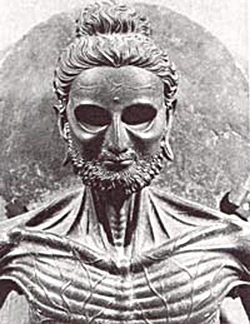
A second century C.E. Gandharan statue of the Buddha during the ascetic phase of his life. From Heinz Bechert and Richard Gombrich, The World of Buddhism (London: Thames and Hudson, 1984), 42.
In Tibet, most monks were ordained at an early age before they were even instructed in religious principles. They entered the monastery with an attitude that was probably more akin to that of children about to attend summer camp. Many of these children probably had little deeply felt devotion to the religious life, at least initially. They entered the monastery simply because this was the wish of their parents. Those few who made such a choice at a more mature age may have entered for religious reasons, but as often as not they may have entered simply to escape the responsibilities that came with traditional family life. It is not surprising that young men should have sought monasticism as a life, or that parents should have wanted such a life for their sons. In Tibet, a monk’s life was financially more secure than that of the typical villager, it afforded one a greater opportunity for education, and it sometimes opened the door to civil service positions in the Tibetan government.1 As in most Buddhist countries, monasticism in Tibet became institutionalized, and the monastic life was for many a profession. This does not mean that some monks did not go on to develop a profound sense of religious vocation, and even a deeply felt sense of renunciation, over the period of their lives. The historical records clearly show that the monasteries produced great saints, individuals who saw the world and its activities as vanities, but these were always in the minority, and even in these cases, such an attitude was something that developed and grew over a lifetime.
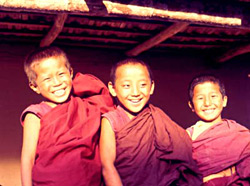
Novice monks of Sera-India.
Formally speaking, a monk or nun is any individual who has taken monastic vows in a Buddhist ordination ceremony.2 Practically speaking, in Tibetan culture, a monk is any male3 with one of three forms of ordination:
- renunciate (rapjung)4
- novice (getsül)
- full ordination (gelong).
Renunciates take the five basic vows of a layman,5 supplemented by a few additional vows that require them to adopt certain monastic behaviors: for example, shaving their heads and wearing robes. Novices take ten vows (sometimes further elaborated in a list of thirty-six).6 Fully ordained monks in the Tibetan tradition take 253 vows.7 All forms of monastic ordination in Tibet are presumed to be for life, even if there exist mechanisms that allow monks and nuns to return their vows – and hence to return to lay life – if they so choose.8 A young boy can take novice ordination when he is old enough to successfully “scare away crows” (about age seven). To take full ordination, one must be at least twenty years of age. The higher levels of ordination require the lower levels as prerequisites. Hence, one must take novice vows before taking full ordination, and one must take lay vows before taking novice (although all of the ordinations can take place within a single day).
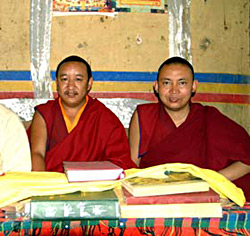
Two fully-ordained monks at Sera-Tibet. Today monks of this age are among the most senior monks of the monastery.
Any official member of Sera is required to have one of these three forms of ordination: renunciate, novice, or full. Typically, young boys take renunciate ordination when they first enter the monastery (either Sera or the monastery in their home region). They may remain at this level of ordination for several years until their teacher decides that they are ready to take novice vows. Since textualists who planned to complete their studies and to obtain the geshé degree had to study the Vinaya, and since the study of the Vinaya required that the monk have full ordination, all serious textualists eventually received full ordination. There were some monks, however, who remained novices their whole lives. Obviously, these were mostly workers (and not textualists). Novice and full ordination ceremonies would usually take place en masse from time to time, and the great scholars and highest lamas of the monastery (or of the Geluk tradition) usually served as the abbot (khenpo)9 on these occasions.
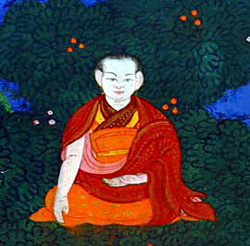
A stylized depiction of a monk in a mural on the portico of one of the regional houses, Sera-Tibet.
It is possessing formal vows (dompa) that makes someone a monk or a nun. Vows are forms of restraint – formal rules that govern behavior – from the most serious (like killing) to the most minor (like spitting). Monastic vows are forms of physical and verbal control. They govern what a monk may/not do with his body, and what he may/not say with his speech. They do not control mental actions. That is, monastic vows are not restrictions about what monks may/not think. Controlling mental action is considered much more difficult, and even if this is the ultimate goal of Buddhism, monasticism is seen only as a preamble (and in some traditions also as a prerequisite) to this more difficult task of controlling the mind. The monks’ vows were meant not only as a way of preparing individuals for mental training, they were also meant to create well-polished gentlemen: upright and noble individuals who would bring honor to the community. Part of the goal of the monastic discipline, therefore, was to create a respectable and dignified community that was worthy of the reverence and financial support of the laity.
The Buddha set forth the vows or regulations as situations arose that required him to offer his opinion/verdict about what were acceptable and unacceptable behaviors for his followers. In this sense the vows represent an inductive moral scheme – built up dialectically in conversation with real human actions – rather than an a priori scheme that is deduced from some set of fundamental moral principles or axioms. Insofar as the discipline is based on the authority of the Buddha, it can also be said to be a dogmatic scheme: it was not negotiable, even if, especially in later times, it became an object of interpretation and debate. How did the list of rules for the Buddhist clergy evolve? Typically, a monk or nun would engage in a certain activity that would be noticed, and considered inappropriate, by his or her colleagues. The action or behavior would be brought to the attention of the Buddha, who would intervene by declaring the activity either acceptable or (more frequently) unacceptable. Over the years of the Buddha’s life, these pronouncements came to constitute a list of proscribed actions that governed all aspects of a monk’s life down to the types of robes and shoes that a monk could wear.
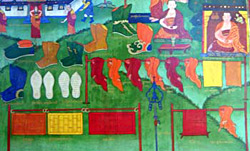
A section of a mural on the wall of one of the regional houses of Sera-Tibet depicts the types of robes and shoes that monks could wear.
In the Tibetan tradition, that follows the Mūlasarvāstivāda Vinaya, the set of proscribed actions came to be codified into a list of two-hundred and fifty-three vows.10 These are further classified into different subcategories according to the gravity of the offense. The most serious, bringing expulsion from the order, are the first four, called “the four defeats” (pampa):
- sexual intercourse
- theft
- killing (of a human being)
- false claims about superhuman abilities
Next, there are the “thirteen community-residue” (gendun lhakma chuksum) rules that include transgressions involving: (1-5) sexuality (masturbation, touching a woman out of sexual desire, etc.), (6-7) improper dwelling places (regulations concerning the site where the monk’s hut is to be built, the size of the abode, etc.), (8-9) falsely accusing other monks of having committed a “defeat” transgression, (10-11) creating schisms in the community, and (12-13) refusing to be admonished. Committing one of these offenses does not bring expulsion form the order, but does involve a process of penance, probation, and reinstatement by the community.
Another lesser set of rules involves things incorrectly acquired or held, which have as their penalty the forfeiture of the item in question. Yet another set, requiring confession, involve incorrect speech (lying, being evasive or uncooperative, maligning others etc.), improperly associating with the laity or with other monks, eating improperly, and so forth. Still more minor rules may incur no penalty at all under certain circumstances, but simply set forth what is considered improper behavior.
In addition to keeping the vows, monks also had to perform certain ritual actions (lé) associated with the Vinaya. Every month on the new and full moon, for example, monks had to perform the purification/confession ritual called sojong. Monks also had to ritually commit themselves to – and ritually release themselves from – the rainy season precepts (e.g., not to travel outside of the official boundary of the monastery for a period of three fortnights).
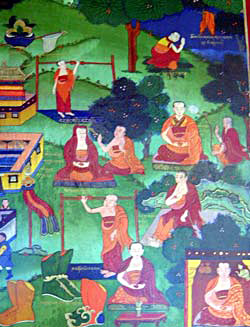
This mural on the wall of one of the regional houses of Sera-Tibet depicts an idealized monastic community performing the various rites prescribed by the Vinaya.
In theory, all monks were supposed to abide by these rules, and to undergo the appropriate punishments and penalties if they did not. In practice, few Buddhist communities probably ever followed the Vinaya exactly to the letter. While the Theravāda tradition of Southeast Asia is arguably the strictest of all the Buddhist traditions as regards Vinaya observance today, this emphasis on the discipline has been a relatively recent phenomenon. And even the monks of the Theravāda tradition do not uphold all of the rules and practices exactly as required by the Vinaya. In Tibet, although the Geluk school is known for emphasizing the importance of the monastic life, even the great seats – the densas, its greatest institutions – did not follow the Vinaya very strictly. At Sera, a monk who committed murder or who was caught having sex with a woman was indeed expelled from the monastery.11 He was stripped of his robes, made to wear a white, soiled garment,12 beaten, and physically cast out from the grounds of the monastery. 13 In regard to other rules, however, Tibetan Buddhist monks have always been more lax. For example, some monks engaged in forms of homosexual sex that while, strictly speaking, not constituting an expellable offense, nonetheless constituted infractions of the lesser rules of discipline.14 In other regards as well Tibetan monks were casual in upholding Vinaya regulations. For example, while monks take a vow not to eat after noon, few monks have traditionally observed this precept in Tibet. Those who do – called gongché, or “evening fasters,” literally, “those who have cut off the evening (meal)” – are few in number. There are also restrictions in the Vinaya concerning what type of meat monks can eat (the meat cannot be from an animal that has been slaughtered specifically for monks), but on special occasions the meals that were offered to monks in Sera’s large assemblies required that many animals be slaughtered.15 From sex to food to the size of their rooms to their interactions with lay people, Sera monks were typical of Tibetan Buddhist monks in disregarding – or else simply accepting their laxity in regard to – many of the rules of the Vinaya. Rather than this making them “bad monks,” it probably only makes them typical of the way that the Vinaya, as an ideal system, has always been practiced in the Buddhist world: with a certain amount of flexibility, and a good bit of compromise.

The first folio of the first text of the Vinaya, the Vinayavastu, in the Tibetan Buddhist canon, the Kangyur.
In the first centuries after the Buddha’s death, all of the traditions associated with the monastic rules came to be codified and systematized in the into an oral – and eventually a literary – corpus of materials that came to be known as the Vinaya (Dülwa), from a verbal root meaning “to discipline.” Thus, in time, the Vinaya came to refer to a collection of texts that, taken as a whole, form one of the three major subdivisions, or “baskets” (denö), of the Buddhist canon.16
Different Buddhist traditions in different Buddhist countries have slightly different Vinayas that were derived from different sects of Indian Buddhism. For example, Theravāda Buddhists follow the Theravāda Vinaya, Chinese Buddhists follow the Mahāsāṃghika vinaya, and Tibetan Buddhists follow the Mūlasarvāstivāda vinaya. The fact that there is considerable unanimity of opinion between these various traditions suggests that the codification of the monastic discipline probably took place at a relatively early date.
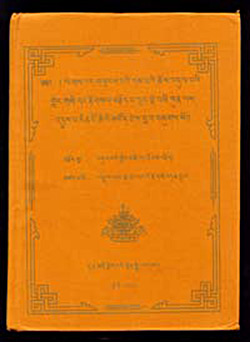
A Tibetan commentary on the Vinaya (Nidāna) by the First Dalai Lama.
The Tibetan Vinaya as a corpus of literary texts takes up thirteen volumes of the 103 volumes of the Tibetan Buddhist canon (Kangyur).17 In addition to these texts, which the Tibetan tradition considers to be the Buddha’s actual words, there is a substantial Indian commentarial literature on the Vinaya found in the commentarial portion of the Tibetan canon (called the Tengyur).18 Finally, there arose in Tibet over the centuries a voluminous native Tibetan literature on the Vinaya: both commentaries (drelpa), and the textbooks (yikcha) that formed the basis for the study of the discipline in the monastic academies. The Vinaya is one of the five major subjects of the Geluk educational curriculum, and monks who reach this point in their studies spend several years solely on these texts – memorizing, studying and debating their meaning. Anyone who wishes to study the monastic discipline as an academic subject has to possess full ordination. Since the geshé degree requires the study of Vinaya, this means, effectively, that only fully ordained monks could become geshés.19
There are many ways of conceptualizing the makeup of the population of Tibetan monasteries. What follows is a presentation of some of the indigenous categories and distinctions operative at Sera, both before and after 1959. You will notice that many, though not all, of these distinctions are hierarchical: that is, they construct differences in such a way that one type will be considered higher than another. A hierarchical view of the world – of people, but also of things – has been an important part of Buddhism from its origin. While the Buddha challenged many of the hierarchicies of his day (caste, for example), this often did not translate into significant differences at the institutional level (the vast majority of early monks appear to have come from the two highest castes). At the same time, it was the Buddha himself who appears to have put into place a fairly strict hierarchy that governed the relationship between the different kinds of clergy, and between the clergy and the laity. In Buddhist terms this hierarchy is constructed as an etiquette: who should show respect to whom, who should bow down to whom. All non-monastics were supposed to bow down to monks and nuns. Even kings (the highest of men) were supposed to bow down to novice nuns (the lowest of ordained women). Within the clergy, nuns of all ranks (including fully ordained nuns) were supposed to bow down to monks of any rank (including novices). Within the order of monks and nuns, respectively, novices had to bow down to their fully ordained peers, and within a single level of ordination, those who were ordained later were supposed to prostrate to those who had been ordained before them. This, in any case, was the theory. In actual Buddhist societies, the etiquette that was practiced was often different. In Tibet, for example, there were some (albeit not that many) saintly laywomen who were sometimes revered and prostrated to even by monks. And very senior, fully ordained monk-scholars often prostrated to very young lamas – recognized incarnates or trülkus – even while the latter were still novices. But even if the pattern was different, with many customs that went counter to the rules of the Vinaya, Tibet was nonetheless an extremely hierarchical society with its own set of rules. This is in part the result of the fact that Tibetan Buddhism is a form of scholasticism: a worldview that revels in creating divisions, distinctions, and in organizing them in clear – and yes, hierarchical – schemes: “Everything in its place!”20
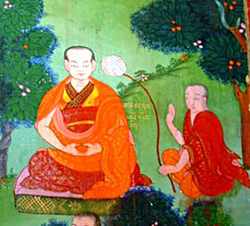
A novice shows his respect for his teacher, a fully-ordained monk. Mural on the wall of the portico in one of the regional houses of Sera-Tibet.
Contemporary European/American views of the world (at least at this point in our history) consider hierarchies problematic, even distasteful. They are seemingly what keep women in a marginalized place, and what allow the rich and powerful to oppress the poor and powerless. There is obviously some truth to this, even if it might be wondered whether hierarchies are not really the symptom rather than the root cause of oppression. At the same time, even Americans (for whom egalitarianism and anti-hierarchicalism are close to dogmas) would concede that certain forms of social structuring and privilege are desirable: students’ respect for teachers, and children’s respect for parents, for example. But my goal here is not to argue for the virtues of hierarchies. It is only to point out that we have our own, and that while Tibet was socially stratified in ways that led to the oppression of many types of people, it was also possible in Tibetan culture to resist – and at times even to overcome – the limitations imposed on one by, e.g., ethnicity, and socio-economic class. This was especially true in the religious sphere. For example, becoming the head of the Gelukpa school – becoming the Ganden Tripa, or “holder of the throne of Ganden” – was mostly determined by one’s abilities as a scholar, and not by one’s class or spiritual status (e.g., as a recognized incarnation). Through their hard work and erudition, many ordinary monks of humble origins from many different parts of Tibet, and even from Mongolia, ascended to the throne of Ganden, to the point where it gave rise to a saying: “The throne of Ganden has no owner” (dga’ ldan gyi khri la bdag po med). This is not to say that the Geluk system as a whole was egalitarian, as will become evident. It is to say that it was, at least in part, meritocratic.
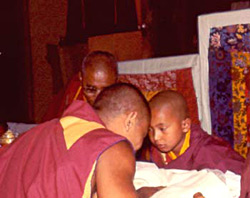
An elder monk seeks the blessing of a young lama, seated on a high throne, during the young boy’s official installation in his college. Sera-India, early 1980s.
Hierarchies in Geluk monasticism presume the notion of status (gosa) – spiritual, scholarly, administrative as well as socio-economic. Understanding status is extremely important to understanding monastic life in Tibet’s great monasteries. Status determined the privileges one enjoyed: the amount of money one received when monetary donations (gyé) were made to the assembly, where one sat in assemblies, the types of vestments one was allowed to wear, and for lamas it determined the height of the throne one sat on.
We have already encountered some of factors that distinguished monks one from another: for example, the level of ordination they possessed, when they were ordained, and so forth. These distinctions are found in the Indian Buddhist Vinaya itself. In this section we will focus on the various ways in which monks were distinguished one from another in a Tibetan, Gelukpa context (i.e., at Sera). One such distinction – a monk’s organizational affiliation (kung) [the distinction between monks based on what college, regional house and household (shak) they belonged to] has been treated in another part of the Sera Project website, and so it will not be mentioned here in any detail. To read that discussion, click here
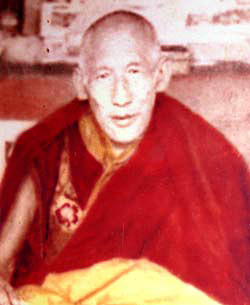
The former holder of the throne of Ganden, Trizur Lhündrup Tsöndrü, early twentieth century. He belonged to the Tsangpa Regional House (Tsangpa Khangtsen) of the Jé College (Dratsang Jé) of Sera.
Before 1959 monks at Sera could be distinguished from several different vantage points. From the viewpoint of origin there were:
- monks who entered Sera directly, i.e., as their first monastery (mostly local monks)
- “continuing monks” (dragyün), who had their home monastery (shigön) in an outlying area, and who came to Sera for the purpose of continuing their studies.
The vast majority of Sera monks came from areas far removed from Lhasa. Usually they first entered a local monastery close to their home, where they memorized the necessary liturgical texts, and where they often began rudimentary philosophical studies. At a certain point, usually in their teens or early twenties, they traveled to the Sera, ostensibly to pursue more intensive studies. "Continuing monks” from the same region of Tibet would often find themselves in the same “regional house” (khangtsen). There were, however, a not insubstantial number of monks who entered Sera directly. These were mostly local boys, from Lhasa, Penpo, and from the various villages close to the capital. Occasionally, a boy from a far-distant region might enter the monastery directly if he had a relative (an uncle, say) or a close family acquaintance already in the monastery, someone who would accept him as his student.
From the viewpoint of what we might call vocation, there were two types of monks at Sera:
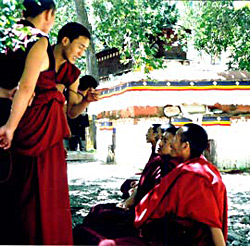
Textualist monks debate in the debate courtyard of the Jé College, Sera-Tibet.
- monks who engaged in studies, called “textualists” (pechewa), and
- those who engaged in the day-to-day work of the monastery, or more simply “workers.”21
By some estimates, less than 25 percent of all the monks living at Sera were textualists. Textualists generally had a higher status than worker monks, both in the monastery and in the society at large. They were perceived as engaging in the type of work for which a monk’s life was intended: study and prayer. This does not mean that they were pampered or uncritically revered. If a textualist got out of line – for example, if he took advantage of workers or became too full of himself – even an uneducated worker monk would be quick to put him in his place.22 Textualists tended to be poorer than worker monks because they spent their free time memorizing and studying, and were thus unable to engage in business or other forms of work to augment their income. Within the category of textualist, monks were further distinguished according to the level they had reached in the curriculum. Monks in the more advanced classes had greater privileges than those in the lower classes, and monks who had completed their studies and who had been awarded the geshé degree occupied one of the highest positions in the monastery, second only to lamas. There were also different ranks of geshés – depending upon whether the degree had been granted internally by the college (rikram), by the monastery’s two philosophical colleges jointly (lingsep), or whether it had been granted by the Tibetan government in public examinations (tsokram and lharam).23 Of the monks who completed the geshé degree many would return to their home monastery to teach. Some would enter retreat. If they had been awarded the higher geshé degree, they could enter one of the two Tantric Colleges (usually for a two-year period, at the end of which they could either return to Sera, go into retreat, or else return to their home monastery). Some geshés would simply remain at Sera and teach after getting their degree.
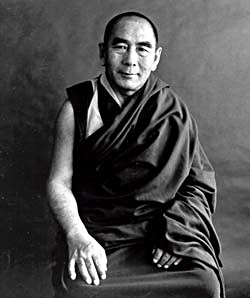
Geshe Sopa (Geshé Zöpa), a geshé lharampa, and one of the most senior geshés of Sera. He lives in Madison, Wisconsin, and is professor emeritus at the University of Wisconsin.
Click one one of the following links to:
- Read an account of the education of textualists in the densas, a selection from a book by Prof. Georges Dreyfus
- Read an excerpt from the life of an eminent, contemporary textualist monk, Geshe Rabten (Geshé Rapten)
- See the daily schedule that a textualist monk traditionally followed.
Workers were of various types. Some worker monks spent their time in various ventures that supplied them with money for living expenses: for themselves and for the members of their household (shaktsen). Others worked for wealthier monks – for example, in lamas’ households (labrang) – where they were provided for. Some monks worked for the various administrative units of the monastery: for regional houses (khangtsen), colleges (dratsang) or for the Sera Lama Society (lachi). Some worked outside the monastery. Monks engaged in a variety of work:
- Kitchen work:
- cooking
- purchasing supplies
- overseeing monk-cooks or hired kitchen staff
- serving tea and food in assemblies
- Serving as caretakers of temples or chapels:
- making offerings on the altars
- cleaning
- receiving the offerings made by pilgrims and worshippers
- serving as guards to ensure that nothing was stolen from altars
- accounting for the goods and money received
- selling religious goods (protection amulets, blessed pills, etc.)
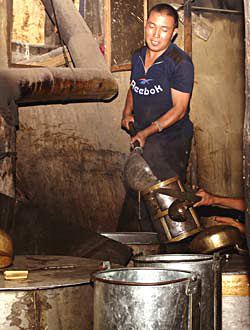
A worker monk in the Tantric College kitchen pours tea into pitchers that will be used to serve the monks in the assembly.
- Serving as part of the ritual staff in specific chapels:
- meeting with prospective patrons who wanted to commission rituals, and providing them with a financial accounting after the fact
- preparing for the ritual (buying the necessary offerings, making ritual cakes, etc.)
- enacting the ritual
- Working as servants or hired-help:
- within the monastery (to lamas, senior teachers, wealthy monks, and administrators)
- outside the monastery (in restaurants, on farms, and in other businesses)
- As artisans, craftsmen, musicians or skilled laborers:
- painting (tangka, statues, wall murals, etc.) (lhadripa)
- building statues (lhazopa)
- serving as musicians (rölyangpa)
- printing texts
- supervising construction projects
- Engaging in business:
- trading (both locally and in outlying districts)
- banking (lending money for interest)
- safeguarding the jewelry or other precious objects that were left as collateral by those who borrowed money
- debt/loan collection
- accounting
- tending the estates (of wealthy lamas, and of the various administrative subunits of the monastery), either as workers or as overseers.
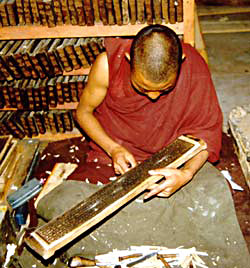
A young monk works with a woodblock from which he will print a text.
Many of these forms of work were looked down upon. They were seen as inappropriate for monks, and even before 1959 there were attempts to reform the monasteries, encouraging monks to give up things like money-lending.24 For the most part, however, these attempts at reform were not heeded. You can learn more about each of these forms of work under Activities.
Many workers were dopdops. These were worker monks who organized themselves into fraternities. These fraternal units – or “parks” (lingka), as they were called – inducted members, did morning group physical workouts, met together for food and ritual, and sporadically convened inter-fraternity athletic competitions. They wore their clothes in a special fashion, donned side-locks, walked with a swagger, and wore special keys on their belts that they used as weapons in fights. They also were known to have a fondness for boys. Sometimes they kept younger monks from within the monastery as their lovers. Occasionally they obtained boys (sometimes by force!) from the local Lhasa community for periods of time.25 The last abbot of the Jé College of Sera before 1959, Geshé Lhündrup Tapkhé, abolished the institution of the dopdop. To read an excerpt from the memoirs of a former Sera dopdop, click here.
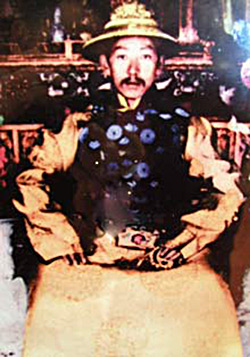
The Fifth Rwa sgreng rin po che, d. 1947, the regent of Tibet who served as temporal ruler between the Thirteenth and Fourteenth Dalai Lamas. He was one of the highest lamas of Sera.
The most important spiritual/metaphysical distinction was that between
- lamas and
- ordinary monks (drapa kyüma).
The word lama is the Tibetan translation of the Sanskrit guru. Technically, anyone who serves as the spiritual mentor of anyone else is a lama. In Geluk monastic parlance, however, lama is essentially synonymous with recognized incarnation (yangsi, or trülku), that is, anyone who is recognized as the reincarnation of a previous teacher.26 The present Dalai Lama has on numerous occasions stressed that this is a bad precedent, claiming that the two terms – lama and trülku – are not synonymous. There are, he says, lamas who are not trülkus (the great scholars who have earned the status of lama by virtue of their scholarly and spiritual accomplishments, but who are not recognized as the incarnations of previous masters), trülkus who are not lamas (people who, while having the status of lama, have no true knowledge or spiritual accomplishments), there are also obviously people who are both (great scholar-saints and trülkus), and people who are neither.
Lamas were further subdivided according to their rank. In order of decreasing rank/status these were:
- lamas who were incarnations of previous kings/regents (Gyeltrül Hotoktu)27
- lamas of the Great Assembly (tsokchen gyi lama),
- lamas of the college (dratsang gi lama), and
- lamas of the regional house (khangtsen gyi lama).
Lamas could also be distinguished according to whether they were “great, medium or small” (lama chekhak; dringkhak; chungkhak), a classification scheme that overlaps with, but appears not to be identical to, the first scheme. Ordinary monks were in essence all monks who were not lamas.28
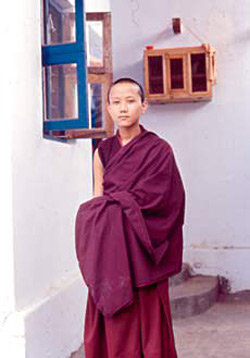
A young lama of Sera Jé, who holds the rank of lama of the regional house. Photo taken at Sera-India in the early 1980s.
Despite the apparently strict, hierarchical nature of the lama/ordinary-monk distinction, this did not always play out in day-to-day life as one might expect. True, lamas (especially lamas of the highest rank) were respected in a variety of ways, but in the densas they also had to prove themselves intellectually. lamas were not exempt from attending debate, and in the debate courtyard what mattered was not one’s status, but one’s mastery of the material, and one’s skill as a debater. Very high lamas may not have always been slandered or jeered at in the heat of a debate the way that ordinary monks were, but they were otherwise treated the same as other monks. Where they did have some advantage – or where they enjoyed special, exceptional treatment, or miksé – was in obtaining official places (the right to debate) in the so-called yearly “Lesser and Greater Lineage Debuts (rik chechung tsoklang).” They also enjoyed some advantage when it came to the selection process in the final stages of obtaining the geshé degree, progressing more swiftly than ordinary monks. Of course, since lamas were almost invariably wealthier than ordinary monks,29 they enjoyed greater leisure that, in theory at least, they would spend in study. Many lamas also had the ability to pay for a live-in tutor (yongdzin), a senior monk who resided in, and was supported by, the lama’s household. In the end, however, everyone in the monastery knew whether or not a lama had what it took to be scholar, and if he did not, the monks were unabashed about claiming that even the highest lama had “little by way of intelligence”30 (rikpa chungchung), or indeed “no intelligence at all” (rikpa minduk).
Because lamas (especially high lamas) often had great power in the Tibetan government, they were often involved in political intrigue. In such cases they were as prone to ridicule and attack as any other political figure, even in Lhasa’s humorous street songs. Some lamas were even imprisoned – and a few were even murdered – as the result of political plots. It should not be thought, therefore, that a lama’s metaphysical status made him immune from criticism, nor from violent reprisal against his person.
Monks were also distinguishable from a socioeconomic viewpoint. We have already mentioned that lamas in general were wealthier than ordinary monks. And, of course, senior scholars and administrators often became wealthy as a result of the positions they occupied. But the vast majority of monks, especially textualists, were poor, often having barely enough to eat. Some monks, however, came from the upper strata of Tibetan society. Members of the aristocracy and wealthy families were supposed to provide for the living expenses of a child who entered the monastery through the institution of the (shakché), or “monk’s share (of the estate).”31 In addition, wealthy families would often, through a large donation to one of the colleges, acquire for their sons the status of “religious devotee” (chöndzé, a position that afforded the boy certain privileges and a higher status (similar to, but not as high as that of lamas).
Monks could also be distinguished in terms of the rank or status they had achieved within the monastery’s administrative hierarchy. In general, having any type of official position as an administrator (lenepa) assured one a greater level of respect. For example, it assured one a better place in the seating arrangement within the assembly hall. Some administrators were also allowed to wear special articles of clothing that ordinary monks could not wear (e.g., special shoes, and vests with brocade). The highest administrators had the privilege of riding horses, and of marching in official government processions (like the procession that escorted the Dalai Lama from and to his two palaces: the Potala and the Norbu Lingkha). Thus, monks could be distinguished by whether or not they occupied administrative positions, and if so, by what position they held. The following is a listing of the major administrative positions. In addition to these there were other minor positions – like “assembly monitor” (lit. “water bearers,” chapri), and temple attendant (lit. “door keeper,” gonyer) – that while official, appointed positions, were not of a sufficiently high rank to fall under the category of “administrator.”
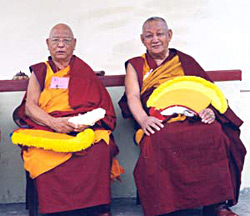
Two abbots of the Jé College, Sera, India. Left, the abbot in 2003, (Khen Rinpoché Lopsang Dönyö); right, (Khenzur Lopsang Tsering), who served as abbot in the early 1990s.
The highest administrative position was of course that of abbot. At Sera, there were four abbots: the abbots of the three colleges (Jé, Mé and Ngakpa), and the Töpa College (Dratsang Töpa) abbot. The latter was an honorary position, the abbacy of a college that had several hundreds of years earlier become defunct. The Töpa abbacy was supposed to rotate between senior geshés of the Jé and smad Colleges. 33 In Sera’s early history there existed something like an abbot of all of Sera, called the “Sera Throne Holder” (Sera Tripa), but this disappeared early on, perhaps when the colleges became the chief locus of power within the monastery. Before 1959, the abbots were appointed by the Dalai Lama or his regent from the ranks of the senior monks. (This continues to be the case in exile.) Traditionally, when a vacancy arose, the senior administration of the college would submit a ranked list of eligible candidates to the Dalai Lama. The latter affixes his seal next to the name of the candidate of his choice. A document of the Jé College cited by Dungkar Rinpoché34 states that the number of candidates for the abbacy is determined by the college’s board of governance (tsokdu) in consultation with the representatives of the regional houses. Disciplinarians (or former disciplinarians) are given preference. If no disciplinarian wishes to be considered, then geshés may be considered (according to seniority). Ultimately, a list of no more than five candidates may be submitted to the Tibetan government. The ranking is determined through a divination enacted before the Jé College tutelary deity, Hayagrīva.
Although there may have existed a fixed term for abbots at different points in Sera’s history, there does not appear to have been a fixed term in recent memory. However, the government could – and sometimes did – exert pressure on an abbot to step down.
Before 1959 the abbacy was extremely powerful. Abbots were both the spiritual leaders and the temporal rulers of the monastery, responsible not only for religious affairs but also for enforcing secular laws and for enacting Tibetan government policy. They were also the most powerful voices on the Council of Ten Lamas (lakhachu), headquartered in the Great Assembly Hall, the highest governing body for the monastery as a whole. In addition, the abbots held important and influential positions in the Tibetan government.
Within the monastery, abbots were responsible for a variety of religious actions: giving formal, ritual admonitions and theme-specific sermons at different points in the calendar year, reciting required Vinaya texts in certain Vinaya-specific rituals, administering “accounting” (tsizhak) examinations to the various classes of textualists during the study periods, supervising debates, and determining the rank of candidates for the geshé degree. Administratively, they were responsible for chairing the meetings of the boards of governance of the college/monastery, for making policy, and for representing the monastery in the Tibetan government.
Abbots often had a large personal staff, headed by their “treasurer” (chakdzö), an individual who wielded a tremendous amount of power in the monastery. Some abbots were strong and able administrators, but not very good scholars. In other cases, they were both: erudite men of great vision and tremendous organization skill. In other instances they were learned yet humble men with little experience or interest in worldly matters. In these cases especially, the treasurers could sometimes serve as shadow-abbots, making most of the decisions concerning the running of the monastery from behind the scenes. Sometimes the treasurers were upright men. Sometimes they were corrupt, seeing the abbacy as an opportunity to enrich themselves and their households.
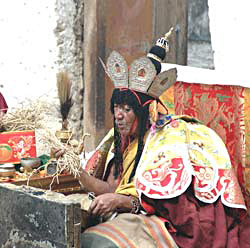
The abbot of the Tantric College, Sera-Tibet, during a ritual function.
Being abbot was no easy thing. Abbots often had to make difficult decisions, decisions that were almost fated to be unpopular with one of two factions: the monks or the government. Their decisions sometimes brought reprisals against them. The most famous example of aggression against a Sera abbot in contemporary times occurred during the controversy surrounding the government’s imprisonment of the former regent, the Fifth Rwa sgreng rin po che , Thub bstan ’jam dpal ye shes bstan pa’i rgyal mtshan, one of the highest lamas of the Jé College, who had been attempting to regain political control of the government from his opponent, Takdrak Rinpoché (the Third Stag brag khri sprul , Ngag dbang gsung rab mthu stobs, 1874-1952). In this struggle, the abbot of the Jé College, the Mongolian Geshé Tendar, took the side of Takdrak against Radreng. This was seen by the Jé monks as form of treason, given that Radreng was a lama of their college (and, indeed, of the abbot’s own regional house). The abbot was confronted, and when he refused to change his position, an angry mob of Sera dopdops murdered him.35 Like lamas, then, abbots were not immune from the fury of their constituents, or from the wrath of the government, for that matter.36 When the monks and the government were at odds with one another, abbots often found themselves caught between a rock and a hard place.
The second highest position was that of disciplinarian, or gekö. Before 1959 each college of Sera had one disciplinarian; the Great Assembly Hall had two, but these were not called gekö but rather zhelngo, a term that literally means something like “presence,”37 but that probably was originally a military term (where it perhaps meant something akin to “lieutenant”). The college disciplinarians were appointed by their respective abbots. Many abbots had originally served as disciplinarians, and so this position could be a stepping-stone to the abbacy (see above). The disciplinarian, whose title literally means “upholder of virtue,” was responsible for maintaining the monastic discipline within the monastery. In the philosophical colleges (Jé and Mé) he was also responsible for supervising the debate sessions (becoming familiar with the quality of individual debaters, deciding when the debate session was to shift from class-debate format to paired-debates, and determining when the debate session was over). He would also give specific, formal sermons on the rules of the college at set intervals in the year.38 The philosophical colleges had two disciplinarians every year: a summer disciplinarian who served for five months, and a winter disciplinarian who served for seven months. The summer disciplinarian was responsible for choosing the candidates for the Lesser and Greater Lineage Debuts.39 College disciplinarians served on the college governing council, and the Great Assembly Lieutenants sat on the Council of ten Lamas.
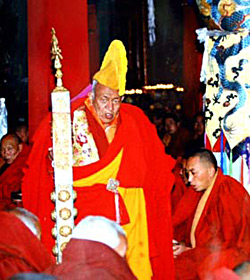 The present chief disciplinarian of Sera-Tibet in full ritual regalia, during an official function in the Great Assembly Hall. He carries in his left hand the “mace,” symbol of his office. | 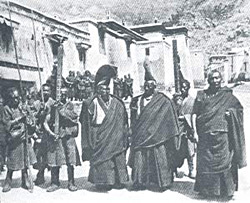 The two lieutenants of the Sera Great Assembly Hall (wearing hats) with their entourages. Taken around 1904. From L. Augustine Waddell, Lhasa and Its Mysteries, With a Record of the British Expedition of 1903-1904 (New York, NY: Dover, 1988, reprint of the 1905 ed.), 373. |
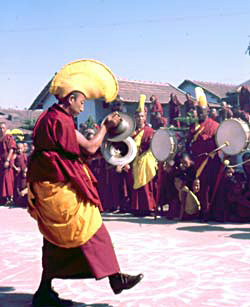
The chant master of the Jé College of Sera-India performs a ritual dance during the annual ritual-cake offering; photo taken in the early 1980s.
Each college had its own chant master, and there was a separate chant master for the Great Assembly Hall. There are two terms in Tibetan used to refer to the chant master: umdzé, which means “leader,” and chenmolak, which means “the great one.” The abbot of each college had the right to appoint his own chant master. A chant master did not serve for a fixed term; and he might serve through multiple abbacies. He was responsible for preserving the special musical/chant traditions of the college, for leading the monks in chant during the various assemblies (in the college, at debate sessions, etc.), and for scripting or directing special ritual events. Obviously, having a good chanting voice was a necessary qualification for such a position. Chant masters also had considerable power beyond their ritual duties. They served on the college governing council, for example, and were partially responsible for supervising lower level administrators.
Each of the colleges had two keepers of the stores. They were appointed by the government from the various regional houses, in rotation. Their term of appointment was for five years. They were chiefly responsible for administering and protecting the endowment (chözhi) of their respective college. At the Mé College (Dratsang Mé), which was not atypical, their charge was quite specific: they needed to invest the college’s moneys in such a way that it produced enough income to provide at least for (a) tea service for the monks during the winter sessions, (b) barley-flour offerings to the monks during the yearly Maitreya Prayer/Offering Festival (Jammön Drupchö), and (c) fried-dough cookies during the New Year (Losar) festivities. 40 The keepers of the stores were also members of the governing board of the college.
There were three administrators called yarchöpa in each of the philosophical colleges who were the equivalent of the keepers of the stores, the same in all respects (method of selection, term, their role in governance, etc.) except for their responsibilities, which focused on raising funds for (a) tea-service to the monks during the summer sessions, and (b) provisions for the monks who went to the winter logic debates (jang günchö).
It was the prerogative of each abbot to select the college secretary. He participated in the governance of the monastery, and was responsible for all formal, written communication from and to the abbot/monastery. The position in theory required good grammar, hand-writing ability and familiarity with epistolary and other formal s of writing.
Literally, the “caretakers of (the monks) in general,” the two chisos appear to be the chief fiscal officers of the Society of Lamas (lachi), which is headquartered in the Great Assembly Hall. They were responsible for all of the financial affairs of that institution, and they sat on the Society of Lamas’ Council of Ten Lamas (Lakhachu).
The zimkhang depa, literally the “government official in charge of the rooms” was responsible for the Dalai Lama’s suite of rooms atop the Great Assembly Hall. Like the provosts, he was part of the Society of Lamas administrative unit, and he sat on the Council of Ten Lamas. He represented Sera as a whole in the Tibetan government. He served for a three-year term, and the position rotated between the three colleges. Together with the two lieutenants of the Great Assembly Hall, he was also responsible for administering the law (religious and “secular”) within the monastery.41 (Besides the two provosts and the “official in charge of the rooms,” the other members of the Council of Ten Lamas were the four abbots, the chant master of the Great Assembly Hall, and its two lieutenants).
All of the positions just described were at the level of the colleges or Society of Lamas (i.e., monastery-wide). In addition to these, there were several important administrative positions at the regional-house level:
- The chief elder (chigen): the main leader of the regional house, usually a learned, senior teacher.
- The regional house “teacher” (khangtsen gegen). This monk was the day-to-day administrator of the regional house. He was also responsible for maintaining the discipline within the regional house. He had to accompany monks who were accused of infractions of the discipline before the college or monastery authorities. The “teachers” were also usually the regional house’s representative to the college’s advisory board.
- The financial officer (chipa): responsible for all fiscal matters.
- The tea master (jama): responsible for the regional house kitchen, and for providing food and tea at all official regional house functions.
Some of the positions and distinctions mentioned above are still operative in Sera-Tibet and in Sera-India, while some are not. In certain instances some of this nomenclature is still used, but with different meanings. In other instances, new nomenclature and new distinctions have emerged. For example, the “Religious Devotee” status no longer exists either in Tibet or in the diaspora.42 The institution of the dopdop is also now defunct, both in India and in Tibet.43 No monk will enter Sera for the sake of becoming a worker monk, or so as to join a fraternity of worker monks. Today it is presumed that all of the monks who enter the monastery do so to become textualists. That this is so in theory does not mean that it is always so in practice, however. In today’s Seras, after several years of study some monks find that they do not have the intellectual gifts (rikpa) or the will/diligence (tsöndrü) to carry out the full program of studies. These monks then become workers or administrators, rotating through a variety of positions in the monastery until they can find one that suits them, and for which they are suited.
To see how terms have changed in meaning, let us consider how the term “continuing monk” (dragyün) is used. In Sera-Tibet today the monks who live in the monastery are divided into those who have official membership (drikzhuk) and those who are living in the monastery but have not yet received official status (dragyün). (The Chinese government limits the numbers of official monks at Sera to 550, and so monks must wait until there is an opening to become official. There is a considerable backlog.) As mentioned above, the term dragyün was used in former times to refer to “continuing monks”: any monk who came from an outlying monastery to continue his studies at Sera. Thus, in former times, one could be an official monk of the monastery and a dragyün. The two terms were not mutually exclusive. Today, the term dragyün refers to those monks – sometimes from outlying areas, sometimes not – who are living in the monastery while waiting to be officially admitted. Thus the word dragyün has the sense of “unofficial monk.” As opposed to the situation in former times, dragyüns in Sera-Tibet today lack many of the privileges that come with being an official monk. In India, on the other hand, the term tragyun is hardly used at all. This makes sense, given that the original sense of the term was linked to Tibetan geography: to the practice of monks coming from outlying monasteries for continuing studies in the capital. In exile, of course, this distinction is mostly moot since all monks, in a sense, come from “elsewhere.”
There has, however, developed another distinction that is relevant to the situation of the diaspora. In India it is now the custom to distinguish monks in regard to whether they are “ripe” (pakha) or “raw” (kucha).44 Ripe monks are chiefly those monks who are part of the first wave of immigrants (or who were born in India to first-wave parents).45 Raw monks are recent immigrants, those who have recently “come off the boat,” so to speak. “Raw” monks are perceived as being linguistically provincial, physically dirty, and culturally naïve. Many recently arrived monks, of course, still preserve the accent of their native region of Tibet, they have not yet adapted their personal hygiene to accommodate themselves to the hot Indian climate, their dietary habits are different, and they are often unfamiliar with many of the hallmarks of “modernity”: to wit, technology.46 The term raw is of course derogatory, and many recently arrived monks resent it. It is interesting, however, that many recently arrived monks come to embrace their “raw” status, and turn it on the “ripe” as a way of critiquing them. In their counter-discourse, they come to equate their rawness with authentic Tibetan identity: the implication being that first-wave Tibetans have lost a good deal of their Tibetanness: that they have, in a sense, passed beyond ripeness to decay/decadence. This is not the place to get into a discussion of the sociology of the diaspora Tibetan community. The point is that as old ways of distinguishing between monks have become obsolete, new ways have emerged to take their place.
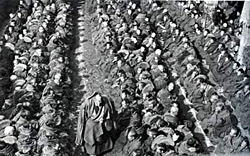
Monks from all three densas at the Great Prayer Festival (Mönlam Chenmo) in Lhasa shows their sheer numbers. From Rosemary Jones Tung, A Portrait of Lost Tibet, Photographs by Ilya Tolstoy and Brooke Dolan (Berkeley: University of California Press, 1980), plate 121.
Sera seems to have grown very quickly after its founding in 1419. So much so that even before Jamchen Chöjé, Sera’s founder, left for his second visit to China a short time after the founding of the monastery, he saw the need to divide the institution up into four colleges.47 A couple of centuries later, by the late seventeenth century, the monastery had a monastic population of 2,850. 48 And in 1904, L. Augustine Waddell informs us that the monastery had six thousand monks.49
By the early twentieth century, a certain oral lore had arisen in Tibet to the effect that Drepung had a monastic population of 7,700, that Sera had 5,500 monks, and that Ganden had 3,300. It is unclear when these obviously stylized figures entered the popular imaginary, but it must have been before the twentieth century.
By my estimate, before the events of 1959, Sera alone had an official enrollment of close to ten thousand.50 This figure was arrived at through interviews with elder Sera monks in Tibet and India in 1991 and 2002. If, as one would expect, monks are most familiar with details concerning their own regional house – the primary site of daily activities – then, short of having access to the monastery’s actual roles, working at the regional-house level is the best way of gaining a sense of the demographics of Sera. Now the fact that there were ten thousand monks “on the books,” so to speak, does not mean that there were this many monks ever living at one time within the perimeter walls of Sera. This is so for two reasons.
- By all accounts, monastic populations could fluctuate by as much as 30 percent within a monk’s lifetime. The figure of ten thousand is the upper limit – a number arrived at by adding up the largest number of monks that an informant could remember as having belonged to his regional house during his lifetime.51
- The figure of ten thousand also includes all of the monks that belonged to the regional house, whether or not they were in residence at the monastery. At any given point in time, many of the monks of a given house might be involved in work that would have taken them outside of the monastery for extended periods of time, even while they remained officially “on the books” (kyiduk).
All of this is to say that in the decades before 1959, there were probably between six thousand and eight thousand monks in residence at Sera at any given time, with an additional undetermined number who, while officially on the monastery’s roles, were living outside of the monastery, sometimes even permanently so.
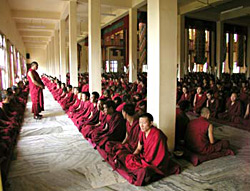
Monks in assembly in the Jé College, Sera-India.
Sera-Tibet today has an official monastic population of slightly less than 550,52 a limit set by the Chinese authorities. It would appear that this number is not completely arbitrary, for it is hardly a coincidence that it should be one-tenth of the classical number of 5,500. In addition to the official monks, there are about half that many “unofficial monks” in residence at Sera-Tibet. A new monk cannot be officially admitted until another official monk has left or died. New monks must therefore wait for extended periods of time to achieve official status, or else resign themselves to having unofficial status, which has many negative consequences, not the least of which is financial (only official monks enjoy the privilege of receiving donations and other forms of funding from the monastery). To make matters even more difficult for the unofficial monk, there are also indications that in recent years (2002) the Chinese authorities had been refusing to allow vacant official monks’ seats to be filled (perhaps as a way of further decreasing the official number of monks in the densas). Chinese policy further limits official status at Sera only to monks who come from the Tibetan Autonomous Region (TAR). Men and boys who hail from Kham and Amdo, for example, are for the most part not allowed to travel to Sera for higher studies.53
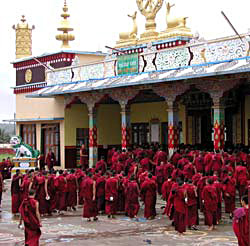
Monks of the Trehor Regional House (Sera-India) file into their regional house temple. Most of the monks of this regional house are new monks from eastern Tibet (Kham).
These various restrictions have led to a steady exodus of young Tibetan monks from the Tibetan regions of the PRC since the late 1980s. Young Tibetan men who want to pursue advanced studies flee to India, where they can realize their educational/religious goals in the diaspora versions of Drepung, Ganden and Sera in the south of India. Since the late 1980s the monastic population of Sera-India, for example, has approximately quadrupled. The largest percentage of the new monks comes from the eastern provinces of the Tibetan cultural world (especially from Kham). This is not surprising, given that it is precisely young monks from these areas that are impeded from entering institutions like Sera-Tibet. In 2002 Sera-India had a monastic population of approximately four thousand monks, almost half the size of pre-1959 Sera, and more than four times the size of present-day Sera-Tibet (if one includes unofficial monks).
Before 1959, monks of all ages (age seven and higher) could be found at Sera. Lacking any real data about the makeup of the monastic community, however, it is difficult to know how many monks there were in each age-group, just as it is almost impossible to know other demographic data like the percentage of rapjung to novices to fully-ordained monks. Because Sera was a monastery for higher philosophical studies, however, we know that the percentage of young monks was lower than what it would be in smaller, outlying monasteries: the monasteries where Sera monks often got their start. Monks at Sera – as in the other densas – were therefore older and slightly more mature than in other monasteries. Today, there are very few young monks (monks under sixteen) in Sera-Tibet. There are also hardly any middle-aged and older monks (monks over forty-five). In Tibet this can be explained in terms of Chinese government policies post-1959, and especially during the Cultural Revolution. From 1960 to about 1980 monasticism was banned, many monks were forced to renounce their vows and to enter lay life, and many monks, as we know, were imprisoned and killed. The few monks that remained are of course the ones who reopened the monastery when this was permitted in the early 1980s. Most of these are now very old, or have since died.
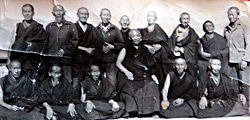
The group of monks who reestablished Sera-Tibet in the early 1980s. Most of these monks are today very old, or else they have passed away.
By contrast, the monastic community in Sera-India is very young: the vast majority of monks are between age six and thirty. As in Tibet, so too in India, there is an entire generation missing: monks in their mid-forties to late fifties. In exile this is due to the fact that most of the monks who left Tibet in 1959 were in their twenties and early thirties. Since the densas in south India were not fully functional until about 1975, Sera monks accepted few new students from 1960 to 1975, and this explains why there are few monks in the forty-five to sixty age group today.
Since any one regional house tended to have monks from several different regions of the country, it is also difficult to come to any firm conclusions about the geographical/regional makeup of the monastic community at Sera before 1959. Because regional houses like Trehor, for example, were quite large and were made up almost exclusively of monks from Kham, we know that there were many monks from this region of Tibet at Sera. In other cases it is difficult to say. For example, Hamdong Regional House (Hamdong Khangtsen), the largest regional house in all of Sera, with over one thousand monks, housed monks from many different regions of Tibet: Lhasa and Amdo principally, but also Inner Mongolia and northern Tibet (Chang). There were also other regional houses that housed monks from Lhasa and Amdo. The point is that even with decent numbers regarding the populations of regional houses, this does not translate into knowledge about what portions of Sera monks came from what region of Tibet. Given that the elder monks who might have some (at least anecdotal) knowledge of this are now quite old, short of getting access to written documents (the monastery’s written roles, for example), it is probable that we will never have any reliable demographic data of this kind.
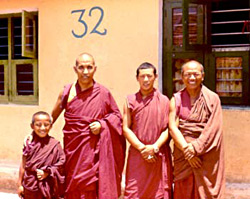 Monks of one household in Sera-India taken in the early 1980s. Today, the two older monks are close to seventy. The two younger monks have since left the monastery |
Dopdops, sometimes translated “punk monks,” were worker monks who belonged to fraternities (lingka). All of the great Geluk academies had such fraternities. The status of dopdops is ambiguous. On the one hand, they had a reputation for being pugnacious, partisan and for having more interests in worldly matters (like sports and boys) than in the religious life. On the other hand, dopdops were known for being forthright, honest, hard-working and extremely loyal (to their fraternities and to their college). They were also known for their generosity and their sense of fairness. What follows are excerpts from the biography of Tashi Khedrup.
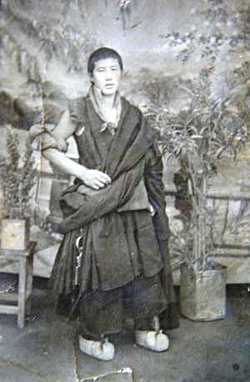
A picture of an anonymous Sera dopdop taken before 1959. Sera Project archival collection, courtesy of Gen Jampa
Tashi Khedrup was born in the village of Tsaparang, a two-day journey from Lhasa, in 1937. At a young age he entered the household (labrang) of the Sharpa Trülku, an incarnate lama of the Kongpo Khangtsen of the Mé College of Sera. After the death of the lama, the young Tashi Khedrup held down a variety of jobs. He lived with nomads on the estates that belonged to the Sharpa Labrang in the region of Dakpo. He was an assistant to the governor of Kyirong, and to the manager of a private estate in Nyimo belonging to a noble family of Lhasa. He even worked in a restaurant for a time. The entire biography is a rich source of information about the life, economics and customs of Sera, and of the non-elite class of Sera monks in particular. The passages excerpted below are reprinted here with the permission of the publisher, Orchid Press.
Tashi Khedrup, Adventures of a Tibetan Fighting Monk, ed. Tadeusz Skorupski, comp. Hugh Richardson (Bangkok: Orchid Press, 1998), 48-51, 55-56, 58-59, 70, 71, 78-80. The narrative begins with Tashi Khedrup’s decision to enter the dopdop fraternity.
Now, at last, I was old enough to join the [dopdops]. No one can be enrolled as a fully-fledged Dob-dob until he is mature and well-grown but I was now big and strong enough to be considered as a candidate. I spoke to my uncle about it, but he was not at all in favour and told me I would be much more sensible to try to get myself a teacher. He was quite calm about it and didn’t really scold me when I said I was determined to go my own way. And so, with the help of my friend Sonam who had already been taken on as a candidate, I got myself accepted in the association of Dob-dobs to which he belonged.
On Dopdops In General
The Dob-dob are a special body of monks, found only in the great monasteries of Drepung, Sera and Ganden, distinguished for their physical strength and courage. Young monks who are strong and active and who can’t find a teacher or are bad at learning, are drawn to join one of the groups into which the Dob-dob organize themselves and which go in for the most strenuous sports and exercises. They used to meet, as soon as it was light, in a sandy valley to the west of Sera, take a shower under a cold waterfall or a dip in a little stream and then run naked in the sand, wrestle, or practise carrying and throwing heavy stones. The most important exercise was long-jumping off a raised ramp and formerly there were great competitions with the Dob-dob of Drepung who were Sera’s long-standing rivals. The competition had to be stopped some time ago because there was a big fight and a monk was killed; but it was a Dob-dob’s ambition to be a good jumper and tough and skilful in all sports.
They did not study books, at least when young, though some of them took trouble to learn to read and write. But they did learn some prayers by heart. One of their tasks was to play the oboe and long trumpet at ceremonies. I think Dote Chandzo [JC: one of Tashi Khedrup’s teachers] sent me to learn music because he knew I wanted to be a Dob-dob. He was one himself and had been involved in a famous fight with a Dob-dob of Drepung, whose teeth he knocked out with a pestle. Dob-dobs could be recognized by the special way they wore their monk’s dress. The skirt part of it was longer than usual, but they kept it kilted up rather higher than the ordinary monks. That gave them a bulky look round the thighs, which they exaggerated by swinging their buttocks as they walked. Their hair was worn rather long, with a big curl trained round the left ear and down on to the cheek, and they often blackened their faces round the eyes to make themselves look fierce. Round their bare right arm, just above the elbow, they always tied a red silk scarf, and they usually had a big, heavy key hanging from their girdle not so much for use as for a weapon.
Dob-dobs are an accepted institution and are recorded as such in the books of their khamtsen. They are not supposed to wear their long locks in the monastery, especially inside the assembly hall; but they manage to hide them by tucking them behind their ears. However, those who are chosen as assistants to the Shengo at the Great Prayer can’t get away with that, and have to sacrifice their treasured hair. To make up for it, they paint a lock in black soot on their cheek and keep it there until the real thing has grown again. Dob-dobs have all sorts of jobs to do as well as playing musical instruments and being a sort of monastery police. They go as bodyguards to monastic officials on their travels; they may even hire themselves to lay officials as traveling escorts. Many of the younger ones help to make and serve the tea in the various assemblies. Those who are good at business or understand farming may become stewards or treasurers of a Labrang, like Dote Chandzo, or of the country estates of a khamtsen.
I know that they have been given a bad name in western books, as quarrelsome, violent bullies who terrorized other monks and went in for immoral practices. That is by no means the whole truth. Any Tibetan will tell you that they are not only often amazingly strong and brave, but are also famous among all for open-handed generosity. It is true that they often fight, but what else can be expected if they are allowed to cultivate strength and daring? And it is true that their fights were often about favourite boys, but what else can be expected in a community of only men and boys? That sort of behaviour was not looked on as exceptionally bad, and probably the people of Lhasa preferred that monks should keep to themselves and not worry their womenfolk. Many of their fights and favourites were in a way just part of a game. It was a long-standing challenge to the Dob-dob to try to carry off some boy of a good family from Lhasa; and that led to fights in the city. In the monastery, too, some of them felt they had to have a fight now and then to prove they were strong and afraid of nothing. There was often no question even of a quarrel, but one of them would challenge some other Dob-dob who fancied himself as a fighter. But it is not true that they spent all their lives in fighting and indulgence. Many never fought at all; and many lived together in lifelong friendship of a simple and natural kind. The toughest of them were often the most generous, and would give away their money freely to some poor monk who was in difficulties, and to laymen too.
Initiation into the Dopdops
The association I joined had about 36 members who came from different colleges all over the monastery. That made it possible to meet a lot of new friends. There was no entrance fee, but each member contributed what he could to a common fund from which we bought food, which we ate in one another’s rooms. Usually meetings were held in the room of the leader who was that one-armed monk who had taught me the oboe. He had been a famous jumper and fighter, but was very quiet in his manner though he saw to it that discipline was properly kept. Clubs of that sort, which we called kyidu – that means that everyone shares the good and bad alike – might last for many years or might break up and reform into new groups. If a member died, a share of his property went to the kyidu, some went to pay the men whose duty it was to cut up his dead body, and the rest to his college.
When I joined the Dob-dob I went to live with my friend Sonam, who had a room of his own. It was a pleasant change from the kitchen of the Labrang, which was always full of people…
As Dob-dob candidates we had to work for the kyidu for several months, cooking for the others and cleaning their rooms and doing odd jobs. We used to go to their exercises every day but were not allowed to take part in the jumping until we were full members. We were under the orders of the jumping master, who kept very strict discipline. We had to lay out our clothes tidily in the right order and only run or throw stones where and when we were told. The master controlled the jumping practice of the Dob-dobs and carried a spade handle with which he marked the distances. It was used, too, to keep order if the candidates were noisy or played the fool. The whole business was taken very seriously. My work in the khamtsen was to look after the horses but there were a lot of novices there, so I did not have nearly so much to do as in the Labrang.
Some days Sonam and I went to the morning assembly in our college and then, when I had finished my work, we would go about with our friends in the Kyidu. Through one of them, called Dawa, I met an older Dob-dob from Drepung known as Nechung Batsa – “Pockmarked Nechung” – because his face was deeply pitted with smallpox scars. Although there was a traditional rivalry, that did not prevent us making friends with monks in Drepung. We often met them in Lhasa and sometimes went quite easily to their colleges. And on our special ceremony in Sera, when a very holy dagger with three sides, which fell from heaven, was brought out to be displayed, the monks of Drepung were always invited to be present. They wore their yellow hats on their left shoulder entertained them to lunch…
The First Fight
About that time I was, I suppose, nearly 15 and, as a Dob-dob candidate, I was on the look-out for a chance to prove my strength and spirit to my friends. In fact, I was quite ready for a fight if one offered. And I had my first that winter before the New Year.
I was waiting one morning on the stone steps outside the Assembly Hall with a lot of other monks. There had been a little snow and we were standing about, wrapped up in our cloaks, trying to warm up in the sun before the gates were opened. I was on the edge of the stone balustrade of the stairway when another monk pushed me off. He was a boy I knew slightly and disliked. There was no particular reason; we just did not like one another; you know how it is. He laughed when I stumbled into the snow, and that made me furious. I leaped at him and hit him on the head with my wooden tea bowl – we all carried them in the pouch of our robe. Other monks restrained us because we had to go into the Assembly, where we glared at one another from a distance. I got out first and lay in wait for him and threw several stones at him. He rushed at me swinging his big key on a strap and hit me on the head. He nearly knocked me out and I was streaming with blood but I had a knife and managed to get at him and hit him in the side and knocked him down. Then I made off in a hurry. Of course, I ought not to have been carrying a knife. That is strictly forbidden except for the monks of a special monastery who carry one with a long flexible blade for making dough offerings. But most Dob-dobs usually had a knife about them somewhere, and sometimes in a fight a monk might get killed. If that happened the killer would be terribly beaten and thrown out of the monastery in a dirty white garment. And anyone found carrying a knife would be flogged even if he had never used it. So I was a bit anxious until I heard that the other boy was not badly hurt.
Lots of people had seen the fight so the Proctors soon heard about it and sent their servants to bring us to them in the Assembly Hall. They asked briefly what had happened and we told the truth. They immediately ordered us to be flogged. The other boy was beaten first and he got 30 double strokes because he had started the fight. I had to kneel on my bare knees and watch. Then the four servants caught hold of me and laid me face downwards on the floor; my robe was pulled up and I was flogged with willow branches by two servants, one on each side, who gave me 25 strokes each in quick succession. Fortunately I knew the servants and they did not take too long about it. It was very painful and drew blood, but I didn’t cry out. It would have been the end of me as a Dob-dob if I had. I bit the fold of my cloak between my teeth to help me.
The other boy and I made it up after that; at least, we did not fight again though we didn’t really like each other any better. My Dob-dob friends were quite pleased with me; and I was quite pleased with myself, too. My buttocks and legs were bruised and sore for a long time but Sonam spread raw egg on them and I lay face downwards in the sun whenever I could. Plentiful dressings of butter helped, too but I suffered a good deal for about a month. I have the marks still…
Life as a New Dopdop
[Finally I became] a fully-fledged Dob-dob and after so long a time away I enjoyed coming back to my kyidu and being allowed to take a more active part in all the activities. I was allowed to join the jumping exercises and had to train by running with my boots full of sand. As I had some money to spend I bought some good new clothes. Dob-dobs were always very proud of their clothes and looked after them carefully. We liked a specially dark shade of expensive, fine woollen cloth for our long skirt-like garment. It had to be folded carefully into a number of pleats, rather like a kilt and when we were in our rooms we usually took it off and put it under a board and sat on it to press the pleats. The front part had to be quite flat, again like a kilt. And I could now grow my hair long. There were strict rules about the exact length and manner in which it had to be cut; the right side was brushed downwards and the left was bunched up into a big curl. We all took a lot of trouble to keep our hair well and rubbed it regularly with vaseline.
For a month or so after I got back from Kyirong I managed to avoid doing much work, but I did go round the college several times to make sure that the older monks were all right. That was regularly done by the Dob-dob, and if anyone was ill or needed help it was generally the Dob-dob who looked after them. Still, there was plenty of spare time, and a party of us used to go in to Lhasa most days. Some of the older Dob-dob would go to a restaurant, or a gambling house or go to look for girls; but I was not interested in those things and what I liked to do was to go where there was singing and dancing and where I could play the flute…
That winter I went again to the Great Prayer. There was a good deal of grumbling and discontent with the Chinese because they wanted to take away the authority of the Shengo to control Lhasa at that season. I stayed in Shasur’s house; and got myself into another fight. I was going by myself early in the morning to reserve a place in the Cathedral when I ran into a party of big Dob-dob, from Drepung, who asked who I was. When I said I was from Sera they insulted me and tried to catch hold of me, saying they would carry me off to live with them. I threatened them with my key and broke away. A little later I found I was bleeding from a deep wound in my left thigh. One of them must have stuck a sharp knife into me, but I hadn’t noticed it at the time. I thought they should not get away with that so I planned to look out for them and challenge them to a fight. I tried to get some of my friends to join me so that we could take on the lot of them. My friends advised me not to start a fight at the Great Prayer because the punishment, if I were caught, would be extra hard. All the same, I did meet one of the Drepung men later and hit him on the head with my key. He seized me by the throat, and we struggled while a lot of other monks looked on. An elderly monk from Sera separated us and, fortunately, we did not hear any more about it. Perhaps the Shengo were too worried about the Chinese to pay attention to a small scuffle like that, but we would have been in trouble if it had turned into a big fight…
I wasn’t ready to settle down yet. It was much more enjoyable to be a Dob-dob. My friends often came to meet in my room and we cooked whatever we had between us and had a good talk, or played dominoes, or sang. In winter there was a brazier of sheepdung on top of charcoal to keep us warm. After the last prayer assembly we were supposed to stay in our rooms by ourselves, and the head of the khamtsen went round to see that all was quiet and that lights were out. We knew when he was coming and lay low; but after he had gone his rounds we would light the lamp again and stay there playing or talking until quite late. Then if it was cold we would all roll up in a ball under whatever blankets we had, and go to sleep. Or sometimes I went to my friends’ rooms for the same sort of party; but we would be up in good time for our exercises in the morning.
Compared with the bookmen monks we Dob-dob were learning nothing. We did go to the assemblies when there was a good distribution of food or money; and we had to be careful to hide our curls, which were not allowed to be worn there. Sometimes, too, we went to listen to the scholars practising debating in the poplar grove where this took place. We found this amusing and would imitate their gestures - stamping, waving rosaries, clapping one hand against the other at arm’s length, and uttering a shout when making a point. We may have picked up some of the argument, too; but the main reason for going was that there was a distribution of food and money there on some days.
Tea Service in the Assemblies
Another thing that took us into the assemblies was that it was one of the Dob-dob’s jobs to serve the tea. That was really work only for the young and strong. The metal teapots were very large and heavy and we had to run with them over floors slippery with the grease that the monks threw out of their bowls when they had drunk the tea. We scattered sand on it from time to time and once a year the floors were scraped and the grease was sold to people from east Tibet who used it for medicine or burnt it as incense in the houses of sick people. It smelt very nasty, but because it came from a monastery it was thought to be very powerful. There might be a good deal of roughness and jostling when the tea was being served, and if a Dob-dob could surprise in the kitchen passage someone he didn’t like, he tried to bash into him with the heavy teapot or to pin him to the wall with it. The tea was made in the kitchens where the lay servants worked. They were a wild and often dishonest lot and stole as much of the supplies as they could. They had a trick of cutting the middle out of a pack of butter and leaving the two ends looking as if it was complete. They were not allowed to wear trousers in the monastery and some of them carried a leather bag between their legs in which they hid anything they could lay their hands on. And they used to take lots of things from simple villagers who wanted to make an offering for the monks’ assembly. The servants, who lived outside the monastery, used to persuade the poor people to give them their presents of dry tea and flour, promising to take them in to the monastery; but they just pocketed the things.
The biggest and most powerful Dob-dob liked to take part in the tea-making by working the big churns in which the liquid tea is mixed with butter. They showed off their strength by thrusting the plunger of the churn down so hard that the butter spouted up to the ceiling. When they did this they wore leather aprons, because they were proud of their clothes and wanted to keep them clean. The kitchen servants, on the other hand, went about simply shining and stinking of old butter.
That business of tea serving led me into another fight. One day, when I was doing it, a group of bookmen monks whom I didn’t know played a nasty trick by sticking a needle in the floor in front of them so that it would run into our bare feet. I was the first to be caught and when I saw them laughing I went to protest. They only laughed and used insulting words under their breath. I could not challenge them there, but I was ready for a fight and told them to wait outside. I was not sure that they would because bookmen usually avoid a fight if they can. But when I came out, there they were. When it was known there was to be a fight, a lot of people crowded round, including some senior Dob-dobs. Three or four of the bookmen came towards me together so I could not see which one to go for. The crowd would not have allowed the whole lot to attack me. That would have been against the custom and quite unfair. But the others distracted my attention so that their champion managed to hit me on the head with his key on the end of a strap. It was quite a severe wound, which bled all over my face. I wiped the blood from my eyes and went for the man with my knife and got him in the groin. He fell down making a terrible fuss, and his friends ran to help him. None of them came anywhere near me. The crowd shouted encouragement to me, and my Dob-dob friends standing in the background were very pleased. If the others had attacked me, they would have come to my help, but it was the rule to leave fighters alone to settle their own business unless a regular group fight has been arranged. At all events my rival did not come back for more, so that was the end. The Proctors did not hear about the fight; or, if they did, they paid no attention. Probably everyone thought the bookmen had gone too far.
Note: The glossary is organized into sections according to the main language of each entry. The first section contains Tibetan words organized in Tibetan alphabetical order. To jump to the entries that begin with a particular Tibetan root letter, click on that letter below. Columns of information for all entries are listed in this order: THL Extended Wylie transliteration of the term, THL Phonetic rendering of the term, the English translation, the Sanskrit equivalent, associated dates, and the type of term. To view the glossary sorted by any one of these rubrics, click on the corresponding label (such as “Phonetics”) at the top of its column.
| Ka | |||||
| Extended Wylie | Phonetics | English | Sanskrit | Date | Type |
|---|---|---|---|---|---|
| kong po khang tshan | Kongpo Khangtsen | Kongpo Regional House | Monastery | ||
| bka’ ’gyur | Kangyur | translated words of the Buddha, the Tibetan Buddhist canon | Title collection | ||
| bkra shis tshe ring | Trashi Tsering | Tashi Tsering | Person | ||
| sku zhabs | kuzhap | reverend | Term | ||
| skyid sdug | kyiduk | a monk officially “on the books” | Term | ||
| Kha | |||||
| Extended Wylie | Phonetics | English | Sanskrit | Date | Type |
| khang tshan | khangtsen | regional house | Term | ||
| khang tshan gyi bla ma | khangtsengyi lama | lama of the regional house | Term | ||
| khang tshan dge rgan | khangtsen gegen | regional house “teacher” | Term | ||
| khams | Kham | Place | |||
| khungs | khung | organizational affiliation | Term | ||
| khri zur lhun grub brtson ’grus | Trizur Lhündrup Tsöndrü | Person | |||
| mkhan po | khenpo | abbot | Term | ||
| mkhan zur blo bzang tshe ring | Khenzur Lopsang Tsering | Person | |||
| mkhan rin po che blo bzang don yod | Khen Rinpoché Lopsang Dönyö | Person | |||
| Ga | |||||
| Extended Wylie | Phonetics | English | Sanskrit | Date | Type |
| go sa | gosa | status | Term | ||
| grwa | dra | monk | Term | ||
| grwa rgyun | dragyün | continuing monks | Term | ||
| grwa pa | drapa | monk | Term | ||
| grwa pa dkyus ma | drapa kyüma | ordinary monk | Term | ||
| grwa tshang | dratsang | college | Term | ||
| grwa tshang gi bla ma | dratsanggi lama | lama of the college | Term | ||
| grwa tshang stod pa | Dratsang Töpa | Töpa College | Monastery | ||
| grwa tshang byes | Dratsang Jé | Jé College | Monastery | ||
| grwa tshang smad | Dratsang Mé | Mé College | Monastery | ||
| grwa log | dralok | monks who leave the monkhood | Term | ||
| gling ka | lingka | fraternal unit of dopdops; park | Term | ||
| gling gseb | lingsep | a geshé degree granted jointly by Sera’s two philosophical colleges | Term | ||
| dga’ ldan | Ganden | Monastery | |||
| dga’ ldan khri pa | Ganden Tripa | Throne Holder of Ganden | Term | ||
| dge bkod | gekö | disciplinarian | Term | ||
| dge snyen | genyen | the five basic vows of a layman | upāsaka | Term | |
| dge ’dun lhag ma bcu gsum | gendün lhakma chuksum | thirteen community-residue | Term | ||
| dge tshul | getsül | novice | Term | ||
| dge lugs | Geluk | Organization | |||
| dge bshes | geshé | Term | |||
| dge bshes bstan dar | Geshé Tendar | Person | |||
| dge bshes bzod pa | Geshé Zöpa | Geshe Sopa | Author | ||
| dge bshes ye shes dbang phyug | Geshé Yeshé Wangchuk | Author | |||
| dge bshes rab brtan | Geshé Rapten | Geshe Rabten | Person | ||
| dge bshes lha ram pa | geshé lharampa | a geshé degree granted by the Tibetan government in public examinations | Term | ||
| dge bshes lhun grub thabs mkhas | Geshé Lhündrup Tapkhé | Person | |||
| dge slong | gelong | fully ordained monk | Term | ||
| dge slong ma | gelongma | fully ordained nun | Term | ||
| dgong bcad | gongché | a monastic who fasts in the evening | Term | ||
| ’gyed | gyé | monetary donations (for the monastic assembly) | Term | ||
| ’grel pa | drelpa | commentary | Term | ||
| rgan byams pa | Gen Jampa | Person | |||
| rgyal sprul ho thog thu | Gyeltrül Hotoktu | incarnation of a previous king/regent | Term | ||
| sgo gnyer | gonyer | door keeper, temple attendant | Term | ||
| sgrigs zhugs | drikzhuk | official membership | Term | ||
| Nga | |||||
| Extended Wylie | Phonetics | English | Sanskrit | Date | Type |
| ngag dbang gsung rab mthu stobs | Ngawang Sungrap Tutop | 1874-1952 | Person | ||
| nges ’byung | ngenjung | renunciation | Term | ||
| sngags pa | Ngakpa | Tantric College, Ngakpa College | Monastery | ||
| sngags pa grwa tshang | Ngakpa Dratsang | Tantric College, Ngakpa College | Monastery | ||
| Cha | |||||
| Extended Wylie | Phonetics | English | Sanskrit | Date | Type |
| chab ril | chapril | water bearers, assembly monitors | Term | ||
| chen mo lags | chenmolak | great one, chant master | Term | ||
| chos mdzad | chöndzé | religious devotee | Term | ||
| chos gzhi | chözhi | endowment | Term | ||
| mchod mjal ’gro mkhan | chönjel dronkhen | worshipper | Term | ||
| Ja | |||||
| Extended Wylie | Phonetics | English | Sanskrit | Date | Type |
| ja ma | jama | tea master | Term | ||
| ’jang dgun chos | jang günchö | winter logic debate | Term | ||
| Nya | |||||
| Extended Wylie | Phonetics | English | Sanskrit | Date | Type |
| gnyer tshang | nyertsang | keeper of the stores | Term | ||
| Ta | |||||
| Extended Wylie | Phonetics | English | Sanskrit | Date | Type |
| tre hor | Trehor | Trehor Regional House | Place | ||
| lta skor ba | takorwa | tourist | Term | ||
| stag brag khri sprul | Takdrak Tritrül | Takdrak Rinpoché | 1874-1952 | Person | |
| stod pa | Töpa | Töpa College | Monastery | ||
| bstan ’gyur | Tengyur | the commentarial portion of the Tibetan Buddhist canon | Title collection | ||
| Tha | |||||
| Extended Wylie | Phonetics | English | Sanskrit | Date | Type |
| thang ka | tangka | scroll painting | Term | ||
| thub bstan ’jam dpal ye shes bstan pa’i rgyal mtshan | Tupten Jampel Yeshé Tenpé Gyeltsen | d. 1947 | Person | ||
| Da | |||||
| Extended Wylie | Phonetics | English | Sanskrit | Date | Type |
| dung dkar rin po che | Dungkar Rinpoché | Author | |||
| dwags po | Dakpo | Place | |||
| drung yig | drungyik | college secretary | Term | ||
| gdan sa | densa | great seat | Term | ||
| ’dul ba | Dülwa | the corpus of monastic rules | vinaya | Doxographical Category | |
| rdo rams pa | dorampa | a geshé degree granted by Drepung Monastery | Term | ||
| ldob ldob | dopdop | punk monk, worker monk | Term | ||
| sde dge | Degé | Organization | |||
| sde gnod | denö | major subdivision of the Buddhist canon | piṭaka | Title collection | |
| sde srid sang rgyas rgya mtsho | Desi Sanggyé Gyatso | Author | |||
| sdom pa | dompa | formal vows | Term | ||
| Na | |||||
| Extended Wylie | Phonetics | English | Sanskrit | Date | Type |
| nor bu gling kha | Norbu Lingkha | Building | |||
| gnas ’khor mkhan | nekhorkhen | pilgrim | Term | ||
| Pa | |||||
| Extended Wylie | Phonetics | English | Sanskrit | Date | Type |
| pe cin | Pechin | Beijing | Publication Place | ||
| po ta la | Potala | Building | |||
| dpe cha ba | pechawa | textualist | Term | ||
| spyi rgan | chigen | chief elder | Term | ||
| spyi pa | chipa | financial officer | Term | ||
| spyi gso | chiso | provost, “caretaker of (the monks) in general” | Term | ||
| sprul sku | trülku | recognized incarnation | Term | ||
| Pha | |||||
| Extended Wylie | Phonetics | English | Sanskrit | Date | Type |
| pham pa | pampa | the four defeats | Term | ||
| phyag mdzod | chandzö | treasurer | Term | ||
| ’phan po | Penpo | Place | |||
| Ba | |||||
| Extended Wylie | Phonetics | English | Sanskrit | Date | Type |
| bai ḍūrya ser po | Baidurya Serpo | Text | |||
| byang | Chang | Place | |||
| byams chen chos rje | Jamchen Chöjé | 1354-1435 | Person | ||
| byams smon sgrub mchod | Jammön Drupchö | Maitreya Prayer/Offering Festival | Festival | ||
| byes | Jé | Jé College | Monastery | ||
| bla kha bcu | Lakha Chu | Council of Ten Lamas | Term | ||
| bla spyi | lachi | lama society | Term | ||
| bla brang | labrang | a lama’s household | Term | ||
| bla ma | lama | anyone who serves as the spiritual mentor of anyone else, recognized incarnation | guru | Term | |
| bla ma cung khag | lama chungkhak | “small” lama | Term | ||
| bla ma che khag | lama chekhak | “great” lama | Term | ||
| bla ma ’bring khag | lama dringkhak | “medium” lama | Term | ||
| dbu mdzad | umdzé | leader, chant master | Term | ||
| dbyar chos pa | yarchöpa | summer session staff | Term | ||
| ’bras spungs | Drepung | Monastery | |||
| Ma | |||||
| Extended Wylie | Phonetics | English | Sanskrit | Date | Type |
| mi rigs dpe skrun khang | Mirik Petrünkhang | Nationalities Publishing House | Publisher | ||
| mon | Mön | Place | |||
| dmigs gsal | miksel | special, exceptional treatment | Term | ||
| smad | Mé | Mé College | Monastery | ||
| smon lam chen mo | Mönlam Chenmo | Great Prayer Festival | Festival | ||
| tsa | |||||
| Extended Wylie | Phonetics | English | Sanskrit | Date | Type |
| tsong kha pa | Tsongkhapa | Person | |||
| gtsang pa khang tshan | Tsangpa Khangtsen | Tsangpa Regional House | Monastery | ||
| brtsi bzhag | tsizhak | accounting | Term | ||
| brtson ’grus | tsöndrü | will, diligence | Term | ||
| Tsha | |||||
| Extended Wylie | Phonetics | English | Sanskrit | Date | Type |
| tshe dbang rin chen | Tsewang Rinchen | Editor | |||
| tshe smon gling | Tsemönling | Monastery | |||
| tshogs chen | Tsokchen | Great Assembly Hall | Building | ||
| tshogs chen gyi bla ma | tsokchengyi lama | lama of the Great Assembly | Term | ||
| tshogs gtam chen mo | tsoktam chenmo | The Great Exhortation | Term | ||
| tshogs ’du | tsokdu | board of governance | Term | ||
| tshogs ram | tsokram | a geshé degree granted by the Tibetan government in public examinations | Term | ||
| Zha | |||||
| Extended Wylie | Phonetics | English | Sanskrit | Date | Type |
| zhal ngo | zhelngo | lieutenant | Term | ||
| zhib ’jug byed mkhan | zhimjuk jenkhen | researcher | Term | ||
| gzhi dgon | zhigön | home monastery | Monastery | ||
| Za | |||||
| Extended Wylie | Phonetics | English | Sanskrit | Date | Type |
| gzims khang sde pa | zimkhang depa | representative to the Tibetan government; “government official in charge of the rooms” | Term | ||
| Ya | |||||
| Extended Wylie | Phonetics | English | Sanskrit | Date | Type |
| yang srid | yangsi | recognized incarnation | Term | ||
| yig cha | yikcha | textbook | Term | ||
| yongs ’dzin | yongdzin | live-in tutor | Term | ||
| Ra | |||||
| Extended Wylie | Phonetics | English | Sanskrit | Date | Type |
| rab tu byung | raptujung | monk | Term | ||
| rab byung | rapjung | renunciate | Term | ||
| rig pa | rikpa | intellect | Term | ||
| rig pa chung chung | rikpa chungchung | little by way of intelligence | Term | ||
| rig pa mi ’dug | rikpa minduk | no intelligence at all | Term | ||
| rigs che chung tshogs langs | rik chechung tsoklang | Lesser and Greater Lineage Debuts | Term | ||
| rigs ram | rikram | a geshé degree granted internally by one of Sera’s two philosophical colleges | Term | ||
| rigs ram pa | rikrampa | a geshé degree granted internally by one of Sera’s two philosophical colleges | Term | ||
| rol dbyangs pa | rölyangpa | musician | Term | ||
| rwa sgreng | Radreng | Monastery | |||
| rwa sgreng rin po che | Radreng Rinpoché | Reting Rinpoché | Person | ||
| rwa sgreng rin po che sku phreng lnga pa | Radreng Rinpoché Kutreng Ngapa | the Fifth Radreng Rinpoché | d. 1947 | Person | |
| La | |||||
| Extended Wylie | Phonetics | English | Sanskrit | Date | Type |
| las | lé | ritual action | Term | ||
| las sne pa | lenepa | administrator | Term | ||
| las byed pa | lejepa | worker | Term | ||
| lo gsar | Losar | New Year Festival | Festival | ||
| log | lok | to return, toturn away from; a mistake | Term | ||
| Sha | |||||
| Extended Wylie | Phonetics | English | Sanskrit | Date | Type |
| shag | shak | household | Term | ||
| shag chas | shakché | monk’s share (of the estate) | Term | ||
| shag tshan | shaktsen | household | Term | ||
| shar pa sprul sku | Sharpa Trülku | Person | |||
| shar pa bla brang | Sharpa Labrang | Organization | |||
| bshad sgrub zung ’brel gling | Shedrup Zungdrel Ling | The Place for Combining Study and Practice | Place | ||
| Sa | |||||
| Extended Wylie | Phonetics | English | Sanskrit | Date | Type |
| se ra | Sera | Monastery | |||
| se ra khri pa | Sera Tripa | Sera Throne Holder | Term | ||
| se ra theg chen gling | Sera Tekchen Ling | Text | |||
| ser smad thos bsam nor bu gling grwa tshang gi chos ’byung lo rgyus nor bu’i phreng ba | Sermé Tösam Norbuling Dratsanggi Chöjung Logyü Norbü Trengga | Text | |||
| ser smad dpe mdzod khang | Sermé Pendzökhang | Publisher | |||
| slob phrug | lopdruk | school children | Term | ||
| gso sbyong | sojong | purification/confession ritual | Term | ||
| bsam blo khang tshan | Samlo Khangtsen | Samlo Regional House | Place | ||
| Ha | |||||
| Extended Wylie | Phonetics | English | Sanskrit | Date | Type |
| har gdong khang tshan | Hamdong Khangtsen | Hamdong Regional House | Place | ||
| lha bris pa | lhapripa | painter | Term | ||
| lha bzo ba | lhapzowa | sculpter | Term | ||
| lha ram | lharam | a geshé degree granted by the Tibetan government in public examinations | Term | ||
| lha sa | Lhasa | Place | |||
| A | |||||
| Extended Wylie | Phonetics | English | Sanskrit | Date | Type |
| a mdo | Amdo | Place | |||
| a ni | ani | nun | Term | ||
| Sanskrit | |||||
| Extended Wylie | Phonetics | English | Sanskrit | Date | Type |
| gandhara | Place | ||||
| the Jé College tutelary deity | hayagrīva | Buddhist deity | |||
| the vinaya which Chinese Buddhists follow | mahāsāṃghika vinaya | Doxographical Category | |||
| the vinaya which Tibetan Buddhists follow | mūlasarvāstivāda vinaya | Doxographical Category | |||
| a commentary on the vinaya | nidāna | Doxographical Category | |||
| lasting happiness, permanent peace | nirvāṇa | Term | |||
| a text containing the Theravāda Buddhist vows | patimokkha | Text | |||
| ascetic | śramaṇa | Term | |||
| a type of Buddhism practiced in most of Southeast Asia | theravāda | Doxographical Category | |||
| the vinaya which Theravāda Buddhists follow | theravāda vinaya | Doxographical Category | |||
| a commentary on the vinaya found in the Tengyur | vinayasūtra | Text | |||
| the first text of the vinaya | vinayavastu | Text | |||